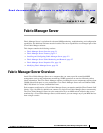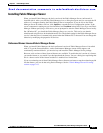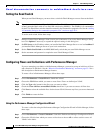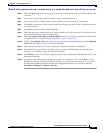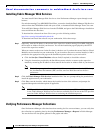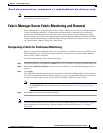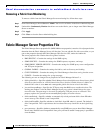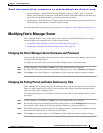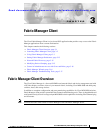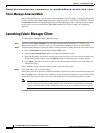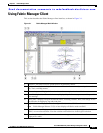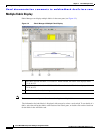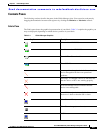
Send documentation comments to mdsfeedback-doc@cisco.com.
2-8
Cisco MDS 9000 Family Fabric Manager Configuration Guide
OL-6965-03, Cisco MDS SAN-OS Release 2.x
Chapter 2 Fabric Manager Server
Fabric Manager Server Properties File
Removing a Fabric from Monitoring
To remove a fabric from the Fabric Manager Server monitoring list, follow these steps:
Step 1 From Fabric Manager, choose Server > Admin. You see a list of fabrics in the Server Admin dialog box.
Step 2 Uncheck the Continuously Monitor check box next to the fabrics you no longer want Fabric Manager
Server to monitor.
Step 3 Click Apply.
Step 4 Click Close to close the Server Admin dialog box.
Fabric Manager Server Properties File
The Fabric Manager Server properties file (MDS 9000\server.properties) contains a list of properties that
determine how the Fabric Manager Server will function. You can edit this file with a text editor, or you
can set the properties through the Fabric Manager Web Services GUI, under the Admin tab.
The server properties file contains these five general sections:
• RMI SPECIFIC—Contains the settings for the RMI registry.
• SNMP SPECIFIC—Contains the settings for SNMP requests, responses, and traps.
• SNMP PROXY SERVER SPECIFIC—Contains the settings for SNMP proxy server configuration
and TCP port designation.
• GLOBAL FABRIC—Contains the settings for fabrics, such as discovery and loading.
• CLIENT SESSION—Contains the settings for Fabric Manager clients that can log into the server.
• EVENTS—Contains the settings for syslog messages.
The following are new or changed server properties for Fabric Manager Release 2.x:
• fabric.globalAlias—Specifies whether Fabric Manager Server should discover aliases from a global
alias server (deviceAlias) or a VSAN-based alias server (fcAlias). Global aliases of a fabric are
fetched if this value is set to true and a manageable global alias server exists in the fabric.
• java.rmi.data.portRange—Specifies the TCP port range that RMI uses to send/receive data. The
starting port number is also the Fabric Manager Server port, so that it should always be set to a
non-zero value. The port range is also used in configuring TCP port access on a firewall. This
property replaces the java.rmi.server.remoteObjPort property in earlier releases.
• fabric.autoReload—Specifies whether to automatically reload persistent fabrics from DB when
server starts up. The default is true if unspecified.
• fabric.loadFromDB—Specifies whether to load fabric from DB when it is opened. The default is
false if unspecified. This is equivalent to the Accelerate Discovery check box on the login dialog
box.
• proxy.autostart—Specifies whether to automatically start SNMP proxy server when Fabric Manager
Server starts. Default is true if unspecified. Note, proxy will not be started if snmp.proxy is specified as
a non-localhost.




